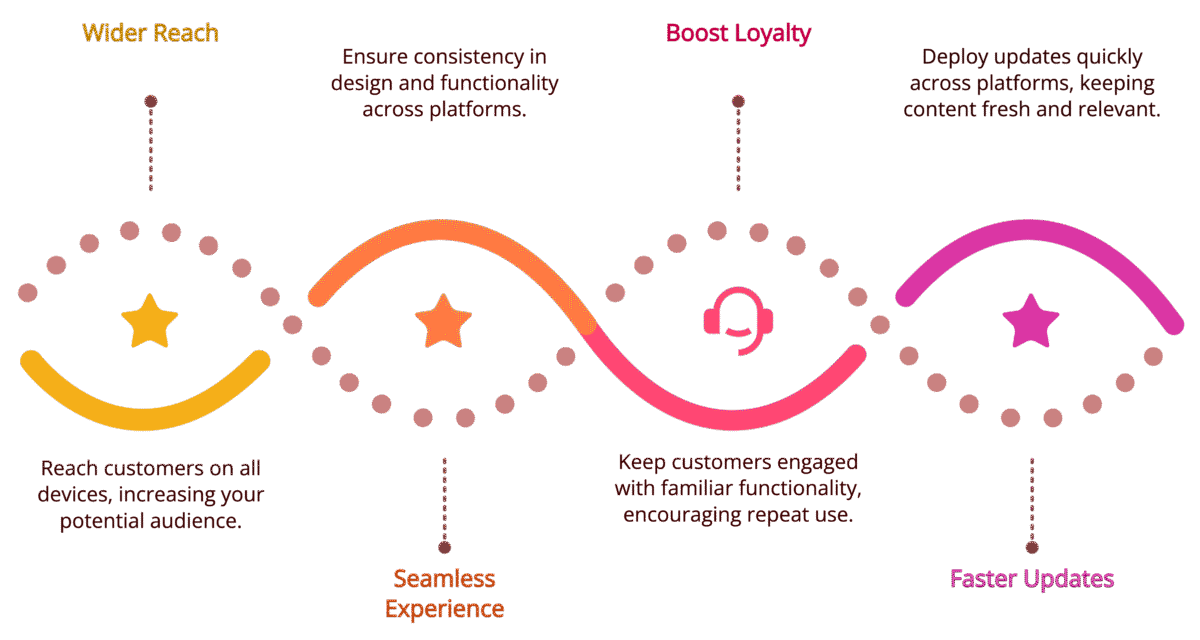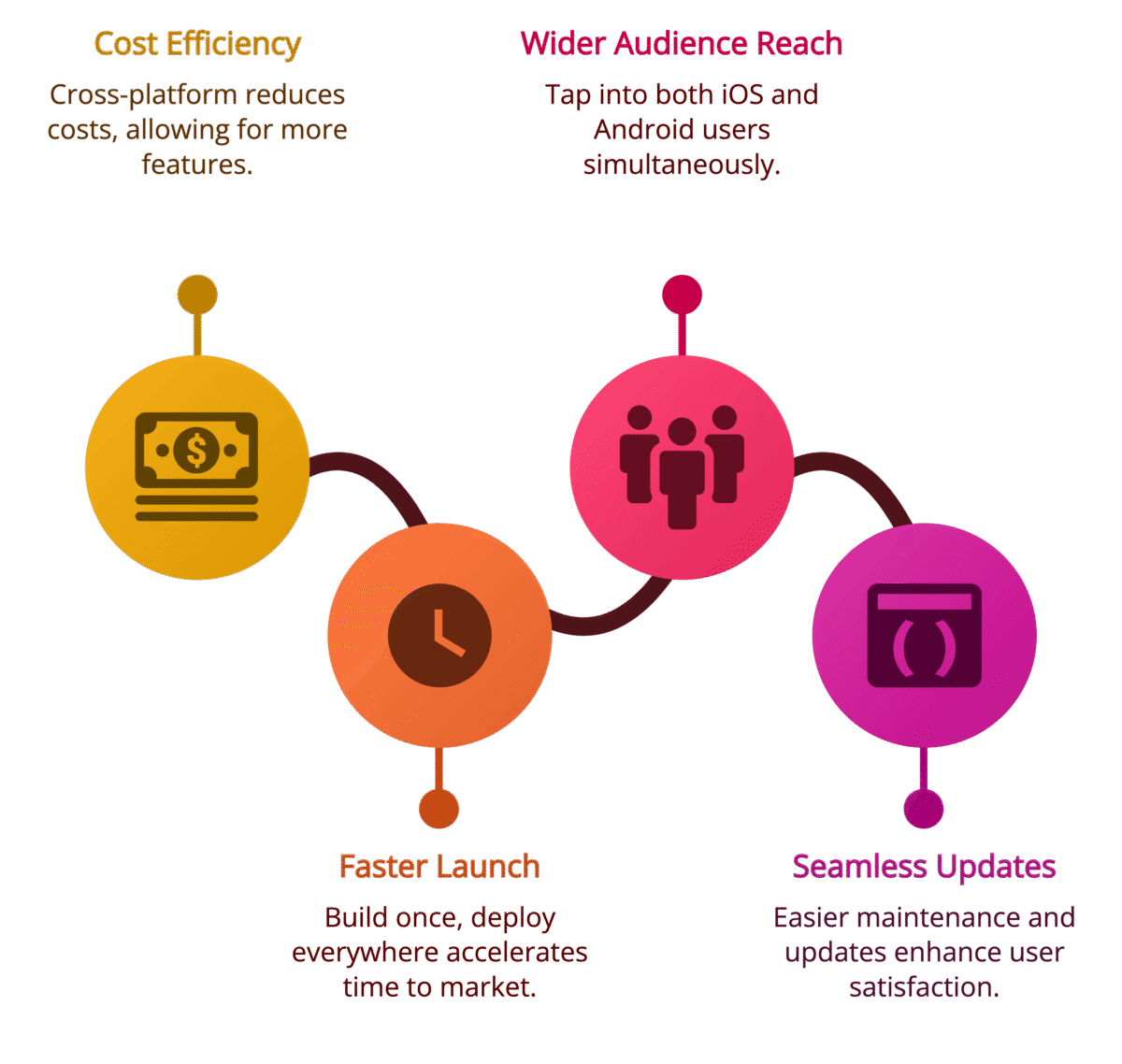
How cross-platform app development can improve customer engagement and retention
Businesses want apps that keep customers coming back. A great app isn’t just useful it’s easy to access, smooth to use, and available where customers need it. Cross-platform app development helps with this by letting businesses build one app that works across multiple devices.
Thank you for reading this post, don't forget to subscribe!This approach saves time and money while boosting customer engagement and retention.
What Is Cross-Platform App Development?
Cross-platform app development means creating a single app that works on both iOS and Android instead of building separate apps for each. Developers use frameworks like React Native, Flutter, or Xamarin to write code once and apply it everywhere.
How It Improves Customer Engagement

When businesses create apps, they want to reach as many customers as possible and keep them coming back. One of the best ways to do this is by building a cross-platform app. It allows you to provide a consistent, seamless experience no matter what device your customers are using. Here’s how it helps improve customer engagement:
1. Wider Reach
In today’s world, customers use all sorts of devices. Some prefer iPhones, while others stick with Android phones or tablets. A cross-platform app helps you meet your customers where they are. Instead of creating separate apps for different operating systems, you can build one app that works on all of them. This approach lets you reach a wider audience without extra effort.
When customers don’t have to worry about whether your app will work on their device, they’re more likely to download and use it. Having a broader reach also means your customer base grows. And with more customers, the chances of repeat engagement and word-of-mouth promotion go up. Simply put, the more accessible your app is, the more customers you can attract and keep.
2. Faster Updates
No one likes waiting around for updates. In the past, businesses had to push separate updates for iOS and Android, which meant longer wait times for users. But with cross-platform apps, businesses only need to update one codebase. That speeds things up significantly.
Faster updates don’t just mean new features they also include bug fixes and security patches. If a problem pops up in the app, customers can get a fix right away, keeping their experience smooth and hassle-free. Security is another key factor. By updating quickly across all platforms, businesses reduce the risk of breaches and show customers they take their privacy seriously.
For customers, this means less downtime and more opportunities to enjoy the app as it evolves. When users see that you are constantly improving the app, they’re more likely to stick around. A constantly improving app keeps customers engaged because it shows them you’re actively working to make their experience better.
3. Better Performance
When it comes to user engagement, performance is everything. No one wants to use an app that lags or crashes. Luckily, modern cross-platform tools offer near-native performance. That means your app can run just as smoothly as one developed specifically for iOS or Android.
Smooth performance is crucial for keeping users engaged. If your app freezes or experiences glitches, users will quickly get frustrated and look for alternatives. With a cross-platform app, you reduce the chances of those performance hiccups. Users can navigate through the app without interruptions, making them more likely to return.
Fast and efficient apps also tend to get higher ratings and better reviews. As positive feedback rolls in, more people are likely to download your app, further driving engagement. A well-performing app not only keeps your existing customers happy but also attracts new ones.
4. Consistent User Experience
When customers use your app, they expect it to feel familiar, no matter which device they’re on. A cross-platform app ensures the design and branding remain consistent across all platforms. This consistency helps build trust and makes it easier for customers to navigate the app, whether they’re using a phone or a tablet.
A familiar design means customers don’t need to re-learn how to use the app each time they switch devices. If your app’s look and feel are the same everywhere, customers can seamlessly transition from one platform to another without getting confused. This level of consistency improves the overall user experience and keeps customers engaged longer.
When users know exactly what to expect from your app, they’ll feel more comfortable using it regularly. This leads to stronger brand loyalty and higher chances of repeat engagement. A consistent user experience fosters a sense of reliability that customers appreciate, which keeps them coming back.
How It Boosts Customer Retention

Building a successful app isn’t just about getting it out there it’s about creating an experience that keeps users coming back. Cross-platform development is a smart way for businesses to save time and money while improving their app. Here’s how it helps:
1. Lower Development Costs Mean More Features
When you develop an app for just one platform say iOS or Android you have to create two separate apps to reach both groups of users. This means double the work and double the costs. But with a cross-platform app, you can build one app that works on both platforms, cutting down on development expenses.
The money saved by not building two apps gives businesses more freedom to invest in other important areas. For example, businesses can use those savings to improve customer service, offer loyalty programs, or add new features to the app. More money for innovation means you can offer customers more value, keeping them engaged and loyal.
Adding more features doesn’t just make your app more interesting it gives users a reason to keep coming back. Whether it’s a better user interface, new ways to interact with the app, or extra tools that solve problems, features make a real difference in keeping your audience hooked.
2. Easier Maintenance and Support
Once your app is live, the work doesn’t stop. Bugs, issues, and updates will always need attention. Cross-platform apps make maintenance much simpler. Since you’re working with a single codebase, any fixes or improvements apply to both platforms at once. There’s no need to go back and make the same change twice, which saves time and reduces the risk of errors.
This also makes it easier for support teams to assist users. When everyone is using the same version of the app, it’s quicker to identify and solve problems. Users won’t be stuck dealing with different versions that have different features or glitches. With consistent performance across platforms, customers get faster help when they need it, which improves their overall experience.
When customers feel like their issues are resolved quickly and effectively, they’re more likely to stay engaged with your brand. They’ll trust that you’re dedicated to providing a smooth experience, which keeps them coming back for more.
3. Faster Time to Market
Getting your app to customers as quickly as possible is essential. Cross-platform development accelerates the entire launch process. Instead of spending extra time developing two separate apps, businesses can launch their app on multiple platforms at once. This means reaching your target audience faster and getting feedback sooner.
With a faster launch, businesses can also test new ideas quickly. If a feature isn’t working or users want something different, you can roll out updates much quicker. Cross-platform apps allow you to gather insights and make changes faster than if you were juggling separate apps for iOS and Android.
Quick feedback means businesses can adapt to what users want in real-time. The faster you respond to customer needs, the more loyal they’ll become. Your ability to meet their expectations directly impacts how often they use your app and how likely they are to recommend it to others.
4. More Engagement Through Push Notifications
Push notifications are a powerful tool for keeping users engaged. They serve as reminders to customers about special offers, app updates, or even abandoned shopping carts. A well-timed push notification can draw users back into the app, increasing retention and boosting sales.
With a cross-platform app, you ensure that all users, regardless of the device they use, receive these important updates. Whether someone is on an iPhone or an Android phone, they won’t miss out on your notifications. This helps businesses create a more unified experience for all customers, improving the chances of re-engagement.
The beauty of push notifications is that they encourage users to take action, whether it’s making a purchase or checking out a new feature. By making sure every user gets the same reminders, you increase the likelihood they’ll return to the app, ultimately boosting engagement and long-term success.
Is Cross-Platform Development Right for You?
If you need an app that reaches the most customers with a fast development time and a lower budget, cross-platform development is a smart choice. However, if your app requires highly advanced features or hardware-specific functions, a native app might work better.
For most businesses, cross-platform development offers the best balance of cost, speed, and user engagement. A smooth, consistent app experience keeps customers happy, engaged, and coming back for more.


